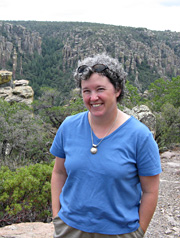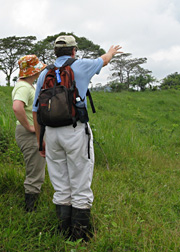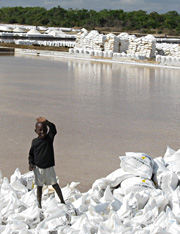October 26, 2010
Q&A with Ann Kinzig

Dr. Kinzig on a research trip in Arizona’s Sky Islands region near the Mexico border.

Dr. Kinzig assesses Panama ecosystems with a colleague from the Smithsonian Tropical Research Institute.

In Tanzania’s Saadani National Park, salt production coexists with ecotourism to supplement a traditional fishing economy.
Ann Kinzig is chief research strategist for the Global Institute of Sustainability, affiliated faculty in the School of Sustainability, and professor in the School of Life Sciences. In her research, she studies ecosystem services, interactions between conservation and development, and the resilience of natural resource systems. She also teaches courses in biodiversity and ecosystem services, urban ecology, current environmental issues, and undergraduate research training.
What triggered your focus on sustainability?
As a graduate student in 1989 with an M.A. degree in physics, I decided to expand my horizons. I went to work with John Holdren (now President Obama’s science advisor) at Berkeley – basically thinking systemically about society’s natural resources and energy requirements and the types of economic and political preconditions for successfully managing them. Two years later, as I was feeling increasingly drawn to the life sciences, the Ecological Society of America published their Sustainable Biosphere Initiative. This was a clarion call for me. Here, suddenly, was a field that allowed one to not only do interesting science, but also help save the world.
What are your most important sustainability-related research projects?
I am wrapping up Advancing Conservation in a Social Context, a grant with the MacArthur Foundation aimed at improving ways to identify, analyze, and negotiate the complex trade-offs between conservation and development. After five years, we can say that conservation organizations are getting better at navigating the trade-offs, but numerous challenges remain. For example, many beneficial natural systems remain undervalued, in part because we lack mechanisms for making difficult choices among different ecosystem services (some of which are delivered globally) and incorporating the value of these services into decision-making at the local level. In response, I plan to work with colleagues at Conservation International to model how ecosystem services are delivered under different policies and landscape configurations. This work builds on an ongoing collaboration between the ASU ecoServices group (faculty and students focused on international biodiversity projects) and the Smithsonian Tropical Research Institute in Panama.
How can your research affect real-world policy decisions?
Our models can tell decision-makers and managers how local policies will affect landscapes and the wider flows of ecosystem services. For example, we are currently working in the Panama Canal Watershed to model the ecosystems that provide water for the locks. If the delivery of water were substantially diminished, the world would see major consequences for global shipping and trade. Our goal is to identify the best landscape configurations for both local and global benefits.
What is the world sustainability challenge that concerns you most?
First, I am concerned about our capacity to understand and manage complex adaptive systems. We have to recognize that these systems are not linear or fully predictable and that policy decisions must be revisited as we monitor results and correct course. A second challenge is that most of our major environmental issues transcend national boundaries. We need global governance mechanisms in place to deal with this.
What are your plans as new chief research strategist for the Global Institute of Sustainability?
My goal is to launch a collective exercise among faculty to imagine what sustainability science should look like a decade from now if it is to serve society. We need to identify both the looming challenges and the gaps in meeting those challenges, and then decide which gaps we at ASU want to fill. One example may be to join our strengths in energy technologies with our knowledge about society and decision-making to improve our understanding of the potential promise and unintended consequences of next-generation energy technologies. Few places examine innovation from both a technological and social perspective, but it is essential in meeting global challenges in a timely fashion without creating new hazards.
October 26, 2010

